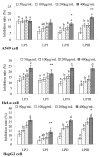Solution properties and in vitro anti-tumor activities of polysaccharides from longan pulp
- PMID: 24051475
- PMCID: PMC6270385
- DOI: 10.3390/molecules180911601
Solution properties and in vitro anti-tumor activities of polysaccharides from longan pulp
Abstract
The solution properties of four fractions (LPI-IV) from crude longan pulp polysaccharides (LP3) were analyzed by size-exclusion chromatography combined with laser light scattering, viscometry, complex formation with Congo red, and atomic force microscopy. Their radii of gyration <S²>(z)(½) were 43.3, 62.6, 43.2 and 77.3 nm, exponents of <S²>(z)(½) = k M(w)(v) were 0.04, 0.50, 0.52 and 0.02, and intrinsic viscosities ([η]) were 9.945, 25.38, 308.2 and 452.1 mL/g, respectively. Moreover, the dependence of [η] on M(w) was established to be [η] = 5.3 × 10⁻²M(w)⁰·⁶¹ (mL/g). LPI had both a sphere-like conformation and a triple-helix structure, and LPII-IV existed as flexible chains. LP3, LPI, LPII and LPIII all exhibited direct inhibitory effects on A549, HeLa and HepG2 cells in a positive dose-dependent manner in the range of 50-400 µg/mL. The activities of LPIII, especially the inhibition of HepG2 cell proliferation, were stronger than those of others, which may be partly related to its flexible conformation. The present results support the cancer therapeutic potential of longan polysaccharides.
Figures






References
-
- Lazareva E.B., Spiridonova T.G., Chernega E.N., Plesskaia L.G., Grunenkova I.V., Smirnov S.V., Men’shikov D.D. Topical pectins for the treatment of burn wounds. Antibiot. Khimioter. 2002;47:9–13. - PubMed
-
- Ovodov I.S. Polysaccharides of flower plants: Structure and physiological activity. Bioorg. Khim. 1998;24:483–501. - PubMed
-
- Yang L., Zhang L.M. Chemical structural and chain conformational characterization of some bioactive polysaccharides isolated from natural sources. Carbohydr. Polym. 2009;76:349–361. doi: 10.1016/j.carbpol.2008.12.015. - DOI
-
- Bao X.F., Wang X.S., Dong Q., Fang J.N., Li X.Y. Structural features of immunologically active polysaccharides from Ganoderma lucidum. Phytochemistry. 2002;59:175–181. - PubMed
Publication types
MeSH terms
Substances
LinkOut - more resources
Full Text Sources
Other Literature Sources

